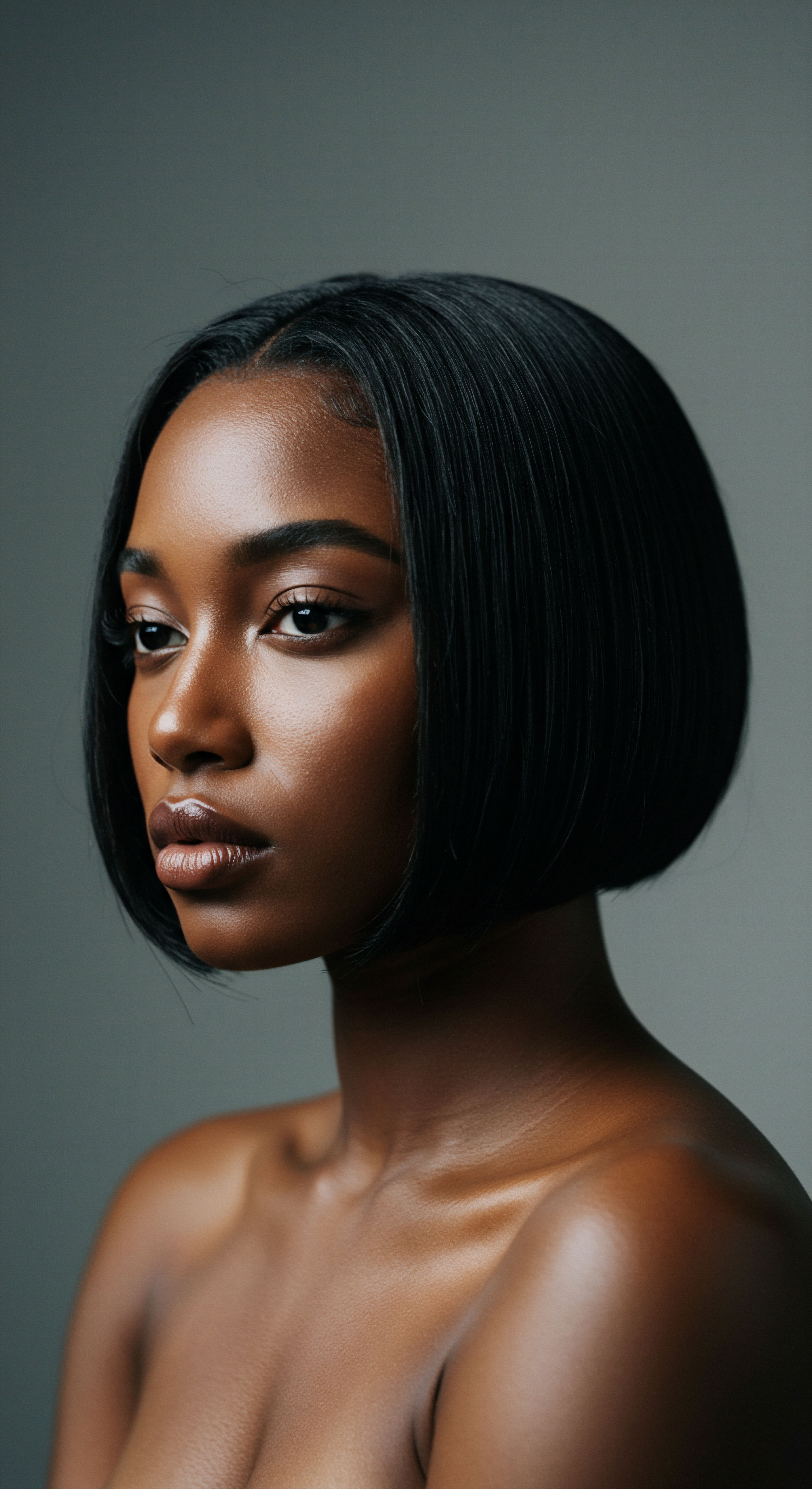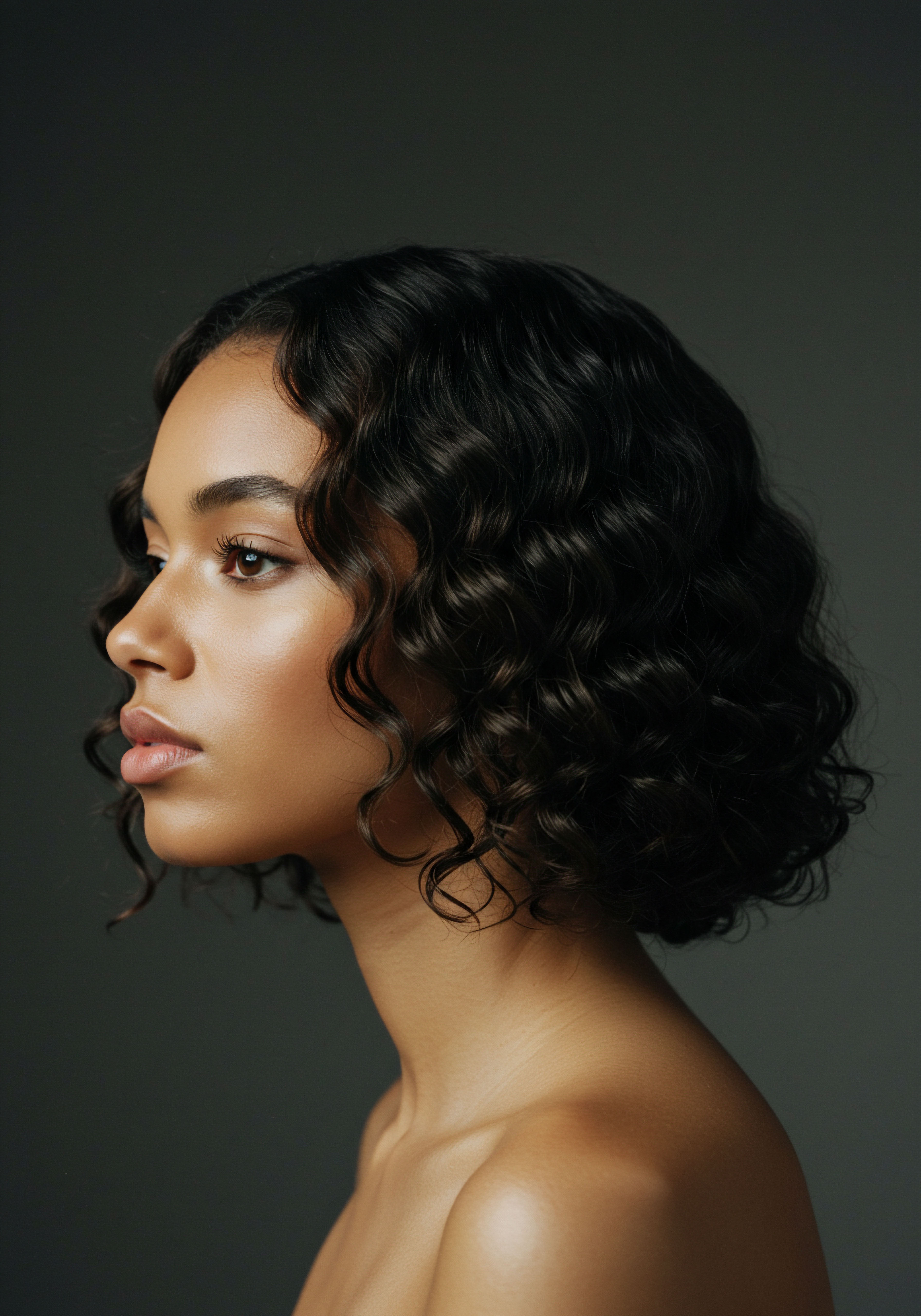
Fundamentals
In the gentle, yet profoundly knowledgeable world of textured hair, understanding the concept of Curl Elasticity is akin to learning the language of your strands. It is a fundamental property, a whispered secret residing within each coil, kink, and wave. At its simplest, curl elasticity signifies your hair’s remarkable ability to stretch without snapping, then gracefully recoil to its original, beautiful shape.
Imagine a perfectly conditioned spring, capable of expanding and contracting with effortless grace; that very quality describes healthy curl elasticity. This characteristic is a vital indicator of your hair’s overall health, resilience, and vitality.
For individuals with textured hair, particularly those within the Black and mixed-race hair communities, this definition holds a special resonance. Our hair, with its unique architectural design, experiences different stresses and demands than straighter hair types. The very nature of a curl, with its bends and twists, means that the hair fiber is not a straight, uniform rod. This inherent curvature, while exquisitely beautiful, introduces points of vulnerability.
Therefore, the capacity for each strand to stretch and return, rather than succumb to breakage, becomes paramount. It’s a testament to the hair’s internal strength and its capacity to withstand the daily rituals of care and styling.
Curl elasticity is the hair’s inherent capacity to stretch and gracefully return to its original form, a key indicator of its vitality.

The Intrinsic Nature of Curl Elasticity
The physical meaning of curl elasticity is deeply rooted in the hair’s microscopic composition. Each strand is primarily composed of Keratin Proteins, arranged in a complex, helical structure within the hair’s cortex. These proteins, along with their intricate disulfide bonds and moisture content, form the internal scaffolding that provides hair with its tensile strength and flexibility. When hair is healthy, these bonds are intact and plentiful, allowing the strand to extend under tension and then spring back.
A hair strand with optimal elasticity can stretch significantly, sometimes up to 50% of its initial length when wet, before reverting to its natural curl pattern. This phenomenon is not merely about preventing breakage; it speaks to the hair’s ability to absorb external forces, whether from detangling, styling, or environmental factors, without suffering lasting structural compromise.
Consider the subtle yet powerful influence of water on this property. When hair is wet, it becomes more pliable, its keratin structure temporarily softened by the absorption of moisture. This allows for greater stretch.
As the hair dries, the water molecules depart, and the keratin structure re-forms, prompting the curl to rebound. This delicate dance between water and protein is central to maintaining good elasticity, especially for textured hair which often requires specific moisture-rich approaches to flourish.

Understanding the Hair Strand’s Core
To truly grasp the significance of curl elasticity, a brief exploration of the hair strand’s layers offers clarification ❉
- Cuticle ❉ The outermost layer, a protective shield of overlapping scales. A healthy, smooth cuticle lies flat, sealing in moisture and protecting the inner cortex. When the cuticle is raised or damaged, moisture escapes, leading to reduced elasticity.
- Cortex ❉ The hair’s thickest layer, residing beneath the cuticle. This is where the majority of the keratin proteins and melanin (which gives hair its color) are found. The cortex is the primary determinant of hair’s strength, elasticity, and texture.
- Medulla ❉ The innermost core, present in some hair types, especially coarser strands. Its exact role is still being fully elucidated, but it contributes to hair volume and strength.
The harmonious interplay of these layers dictates how well a curl can stretch and return. A compromised cuticle can hinder the cortex’s ability to retain the moisture essential for elasticity, leading to a diminished capacity for stretch and an increased propensity for breakage.
The unique structural elements of Afro-textured hair, such as its elliptical cross-section and the irregular distribution of cortical cells, mean that understanding and nurturing elasticity takes on added importance. These inherent characteristics, while creating magnificent curl patterns, also contribute to areas of weakness along the hair shaft, making them more susceptible to mechanical stress.

Intermediate
Moving beyond the foundational meaning, an intermediate understanding of Curl Elasticity delves into its practical manifestations and the daily rhythms of textured hair care. Here, the explanation extends to how this property directly influences your hair’s responsiveness to products and styling, shaping your entire hair journey. A strand with adequate elasticity feels supple and alive; it responds to gentle manipulation with a satisfying spring. Conversely, hair lacking this vital attribute might feel rigid, brittle, or limp, resisting attempts at styling and often leading to frustration.

Assessing Your Hair’s Elasticity ❉ The Gentle Stretch
One of the most accessible methods to gauge your hair’s elasticity is the simple Stretch Test. This involves taking a single strand of wet hair—as wet hair provides a more accurate assessment due to its increased pliability—and gently stretching it. Observe its behavior with thoughtful attention ❉
- Healthy Elasticity ❉ The strand stretches considerably, then gracefully recoils to its original length without breaking. This indicates a beautiful balance of moisture and protein within the hair.
- Low Elasticity (Dryness) ❉ The strand stretches very little and snaps easily. This often signals a significant lack of moisture, leaving the hair brittle and fragile.
- Low Elasticity (Protein Overload/Moisture Overload) ❉ The strand stretches excessively but does not bounce back, remaining limp and mushy, or it feels stiff and breaks with minimal tension. This suggests an imbalance, either too much protein without sufficient moisture, or an overwhelming excess of moisture.
This simple observation offers a profound insight into your hair’s current state, guiding your choices in conditioners, masks, and styling agents. The results of this test provide a personalized map for nurturing your curls.
A simple stretch test reveals your hair’s protein-moisture equilibrium, guiding personalized care for vibrant curls.

Factors Influencing Curl Elasticity in Textured Hair
Several elements, both internal and external, play a significant role in determining the health and expression of curl elasticity, particularly for Black and mixed-race hair.
- Moisture Levels ❉ This is perhaps the most critical factor. Textured hair, by its very nature, tends to be drier than straighter hair types because the natural oils (sebum) produced by the scalp struggle to travel down the curves and coils of the hair shaft. Well-hydrated hair possesses superior elasticity, as water molecules allow the keratin structure to be more flexible. When hair is parched, it loses its suppleness, becoming stiff and prone to breakage.
- Protein Balance ❉ Hair is, at its core, protein. Keratin provides the structural integrity. However, a delicate balance is required. Too little protein can lead to weak, overly stretchy, and limp hair that lacks definition. Conversely, an excess of protein, especially without adequate moisture, can render hair stiff, brittle, and prone to snapping, resembling straw. Finding the optimal protein-moisture equilibrium is a constant, intuitive dance for textured hair.
- Chemical Treatments ❉ Processes like relaxing, perming, coloring, or bleaching fundamentally alter the hair’s disulfide bonds, which are crucial for its strength and elasticity. These treatments, while offering transformative styling options, can severely compromise the hair’s natural ability to stretch and rebound, leading to permanent structural changes and increased fragility.
- Heat Styling ❉ Frequent or excessive use of heat tools (flat irons, curling wands, blow dryers) can strip the hair of its internal moisture, leading to a loss of elasticity. High temperatures can even alter the protein structure of hair, converting alpha-keratin to beta-keratin, which weakens the hair and reduces its natural bounce.
- Mechanical Stress ❉ Daily manipulation, such as aggressive detangling, tight hairstyles, or friction from rough fabrics, can exert undue stress on the hair shaft. Textured hair, with its inherent points of curvature, is particularly susceptible to damage from mechanical forces, leading to breakage and reduced elasticity over time.
Understanding these influences allows for a more informed and gentle approach to textured hair care. It shifts the focus from merely styling to actively preserving and enhancing the hair’s intrinsic health and resilience.
| Elasticity Level High Elasticity |
| Characteristics Stretches significantly (up to 50% when wet) and springs back instantly. |
| Typical Feel Supple, bouncy, vibrant, resilient. |
| Elasticity Level Medium Elasticity |
| Characteristics Stretches well (30-50%) and returns to original shape, may take a moment. |
| Typical Feel Healthy, manageable, good body. |
| Elasticity Level Low Elasticity (Dry) |
| Characteristics Stretches minimally, snaps easily, feels rough. |
| Typical Feel Brittle, stiff, crunchy, prone to breakage. |
| Elasticity Level Low Elasticity (Over-moisturized) |
| Characteristics Stretches excessively but does not recoil, feels mushy or gummy. |
| Typical Feel Limp, shapeless, overly soft. |
| Elasticity Level Assessing elasticity helps tailor care routines for optimal hair health. |

Advanced
At the advanced echelon of understanding, the Meaning of Curl Elasticity transcends a simple definition; it becomes a lens through which to comprehend the profound interplay of biology, heritage, and contemporary hair science, particularly for textured hair, Black hair, and mixed-race hair. Here, curl elasticity is understood as the hair fiber’s intrinsic biomechanical capacity for reversible deformation under stress, a property deeply influenced by its unique morphology, keratinous architecture, and hydration dynamics. It is a critical determinant of hair’s overall mechanical integrity, its susceptibility to damage, and its response to various chemical and physical interventions. This complex characteristic reflects not only the immediate health of the hair but also its historical journey and the scientific challenges inherent in its study.

The Biophysical Underpinnings of Curl Elasticity
The precise delineation of curl elasticity at this level requires an examination of the hair fiber’s molecular and cellular composition. The hair shaft, a complex biological polymer, derives its elasticity primarily from the alpha-helical structure of its keratin proteins within the cortex. These helices are stabilized by disulfide bonds, hydrogen bonds, and ionic interactions. When a hair strand is stretched, these bonds allow the keratin helices to uncoil, absorbing the tensile force.
Upon release, the bonds reform, and the helices recoil, returning the hair to its original state. The greater the integrity and abundance of these bonds, coupled with optimal hydration, the higher the hair’s elastic modulus and its capacity for rebound.
However, for Afro-textured hair, this biophysical reality is further complicated by its distinctive morphology. Unlike the typically round or oval cross-sections of Caucasian or Asian hair, Afro-textured hair often exhibits an elliptical or flattened cross-section with significant variations in diameter along its length. This inherent curvature creates regions of varying stress concentration, making the fiber intrinsically more vulnerable to mechanical strain.
Research has shown that African hair tends to have a lower break stress and percentage extension at break compared to Asian and Caucasian hair. This implies a reduced capacity to withstand stretching before fracture, a critical consideration for hair care practices.
Curl elasticity in textured hair is a complex biomechanical attribute, influenced by its unique elliptical morphology and keratinous architecture.

Cultural and Historical Contexts of Hair Resilience
The significance of curl elasticity extends beyond mere scientific parameters, touching upon the deep cultural and historical narrative of Black and mixed-race hair. For centuries, Black hair has been a canvas for identity, resistance, and self-expression. Yet, it has also been a site of immense pressure and discrimination, with Eurocentric beauty standards often devaluing natural textures. This historical context shapes the very care practices and perceptions surrounding hair elasticity.
The pursuit of straightened styles, often achieved through harsh chemical relaxers or intense heat, directly compromises hair’s natural elasticity by permanently altering its disulfide bonds. This historical drive for conformity, while rooted in systemic racism and societal pressures, has had tangible, long-term consequences for hair health within the community. The inherent fragility of Afro-textured hair, combined with aggressive styling practices, has historically contributed to issues like traction alopecia and increased breakage.
A fascinating, though often overlooked, aspect of textured hair science involves the interaction of lipid content and water management. African hair, despite often being characterized as dry, possesses a higher lipid content, particularly apolar lipids, compared to other hair types. While this might seem counterintuitive, this lipid distribution can reduce water swelling by impeding water entry into the hair fiber.
This distinct property, coupled with the hair’s high curvature, contributes to its perceived dryness and susceptibility to breakage. This understanding challenges simplistic notions of “dry hair” and underscores the need for hair care strategies that acknowledge the complex lipid-water dynamics unique to textured strands.

Advanced Considerations ❉ Protein-Moisture Balance and Genetic Predisposition
The concept of Protein-Moisture Balance is not simply a care tip; it is a sophisticated biochemical equilibrium. Hair requires both structural proteins (keratin) for strength and water for flexibility and stretch. An imbalance tips the scales towards either brittleness (protein overload) or excessive limpness (moisture overload), both of which manifest as poor elasticity. The precise “sweet spot” for this balance is unique to each individual, influenced by genetics, hair care practices, and environmental factors.
Genetic factors also play a significant, yet complex, role in determining hair texture and, by extension, its inherent elasticity. Genes such as KRT71, KRT74, KRT85 (keratin genes), and the Trichohyalin (TCHH) Gene influence the shape of hair follicles and the arrangement of keratin proteins, directly impacting curl pattern and elasticity. The polygenic nature of hair curliness means that multiple genes interact, creating a spectrum of textures and varying degrees of inherent elasticity. This genetic blueprint dictates the baseline, but extrinsic factors and care regimens determine how that potential is realized or compromised.

Innovations and Research in Textured Hair Elasticity
The scientific community continues to unravel the complexities of textured hair, moving beyond generalized assumptions. For instance, a noteworthy 2020 study published in the International Journal of Trichology illuminated a critical imbalance in protein-moisture levels among African American women with high porosity hair. The research indicated that 65% of Participants Exhibited an Excess of Moisture without Adequate Protein Support, While 25% Suffered from Protein Overload Due to Improper Treatment Use.
Only a small 10% had achieved an optimal balance. This striking data point underscores a prevalent challenge within the community ❉ a significant majority are struggling with protein-moisture disequilibrium, directly impacting curl elasticity and contributing to breakage.
Further, a 2021 study in the Journal of Cosmetic Science highlighted the potential of specific amino acids—Cysteine, Arginine, and Methionine—to significantly improve the structure and health of high porosity hair in African American women. Participants using a regimen incorporating these amino acids experienced a 45% reduction in breakage and a 60% improvement in moisture retention over 12 weeks. This research offers a compelling direction for targeted product development and personalized care, moving beyond generic solutions to address the precise biochemical needs of textured strands.
| Practice/Factor Optimal Hydration |
| Effect on Elasticity Increases |
| Mechanism/Explanation Moisture plasticizes keratin, allowing greater stretch and rebound. |
| Practice/Factor Protein Treatments (Balanced) |
| Effect on Elasticity Improves |
| Mechanism/Explanation Hydrolyzed proteins temporarily fortify the cortex, enhancing strength and preventing excessive stretch. |
| Practice/Factor Chemical Relaxers/Perms |
| Effect on Elasticity Decreases significantly |
| Mechanism/Explanation Break disulfide bonds, permanently altering hair structure and reducing its natural ability to recoil. |
| Practice/Factor High Heat Styling |
| Effect on Elasticity Decreases |
| Mechanism/Explanation Dehydrates hair, denatures keratin proteins (alpha to beta conversion), leading to rigidity and breakage. |
| Practice/Factor Aggressive Detangling |
| Effect on Elasticity Decreases (leads to damage) |
| Mechanism/Explanation Mechanical stress on inherent weak points in curled fibers causes micro-fractures and loss of integrity. |
| Practice/Factor Informed care practices are crucial for maintaining and restoring optimal curl elasticity. |

The Corporate and Expert Perspective on Curl Elasticity
From a corporate and expert standpoint, the understanding of curl elasticity is not merely academic; it is a strategic imperative. The unique biomechanical properties of textured hair, particularly its inherent fragility and distinct hydration needs, represent both a challenge and a significant market opportunity. Companies investing in advanced hair science recognize that generic hair care solutions often fall short for these hair types. The focus shifts to developing formulations that address the specificities of disulfide bond distribution, lipid content, and water absorption unique to highly curved fibers.
Long-term success in this segment hinges on research-driven product development that prioritizes genuine hair health over temporary cosmetic fixes. This involves ❉
- Targeted Ingredient Science ❉ Moving beyond generic humectants and emollients to ingredients that actively support the protein-moisture balance and reinforce the hair’s internal structure. This includes specialized protein complexes, amino acid blends, and lipids that mimic or enhance the hair’s natural protective barriers.
- Non-Invasive Testing Methodologies ❉ Advancements in trichology are leading to more sophisticated, non-destructive methods for assessing hair elasticity and structural integrity, moving beyond the simple stretch test to microscopic analysis and spectroscopic techniques. These provide precise data for product efficacy and personalized recommendations.
- Educational Empowerment ❉ Brands and experts who prioritize educating consumers about the science of their hair, including concepts like curl elasticity, build trust and loyalty. This involves demystifying complex biological processes and translating scientific findings into actionable care strategies, allowing individuals to make informed choices that truly benefit their hair’s long-term health.
The future of textured hair care, viewed through the lens of curl elasticity, lies in a collaborative approach that unites scientific rigor with cultural sensitivity, creating solutions that not only enhance beauty but also preserve the inherent strength and dignity of every curl.

Reflection
As we draw our exploration of curl elasticity to a close, a sense of profound appreciation settles over the journey. This characteristic, often overlooked in its simplicity, truly holds the secret to hair that thrives, not just survives. For textured hair, it is a testament to resilience, a quiet strength that speaks volumes about its inherent beauty and complexity. Understanding this vital property is not merely about scientific knowledge; it is an invitation to listen to your hair, to honor its unique requirements, and to cultivate a relationship built on informed care and deep respect.
Each stretch and recoil tells a story of health, of past experiences, and of the potential for future vibrancy. May this insight empower you to nurture your curls with gentle hands and a knowing heart, allowing their natural bounce and brilliance to shine.

References
- McMullen, Roger L. Tim Gillece, and Tyler Schiess. “Physicochemical Properties of Textured Hair.” Journal of Cosmetic Science 72, no. 6 (2021) ❉ 711-731.
- Davis-Sivasothy, Audrey. The Science of Black Hair ❉ A Comprehensive Guide to Textured Hair Care. Sivasothy Publishing, 2011.
- Porter, Catherine, et al. “The Mechanical Properties of Hair.” Journal of Cosmetic Science 56, no. 5 (2005) ❉ 315-325.
- Khumalo, Ncoza C. et al. “Hair Breakage in Patients of African Descent ❉ Role of Dermoscopy.” Clinical, Cosmetic and Investigational Dermatology 8 (2015) ❉ 450-465.
- Franbourg, Aurélie, et al. “Current Research on Ethnic Hair.” Journal of the American Academy of Dermatology 48, no. 6 (2003) ❉ S115-S119.
- Loussouarn, Genevieve, et al. “Diversity in Human Hair Growth, Diameter, Color and Shape.” Cosmetics 6, no. 3 (2019) ❉ 36.
- McMichael, Amy J. and Valerie D. Callender. Hair and Scalp Diseases ❉ Medical and Surgical Approaches. CRC Press, 2018.
- Robbins, Clarence R. Chemical and Physical Behavior of Human Hair. 5th ed. Springer, 2012.
- Khumalo, Ncoza C. et al. “Traction Alopecia ❉ The Root of the Problem.” Clinical, Cosmetic and Investigational Dermatology 1 (2008) ❉ 93-102.
- Gavazzoni Dias, Maria Fernanda. “Hair Cosmetics ❉ An Overview.” International Journal of Trichology 7, no. 1 (2015) ❉ 2-15.
- Byrd, Ayana, and Lori Tharps. Hair Story ❉ Untangling the Roots of Black Hair in America. St. Martin’s Press, 2001.
- Walton, Nikki. Better Than Good Hair ❉ The Curly Girl Guide to Healthy, Gorgeous Natural Hair! HarperCollins, 2013.
- Park, Kimum. “Hair Damage and Hair Repair Treatments Affect Water Uptake into Hair and Hair Swelling.” Poster presentation at the TRI/ITC Multi-Ethnic Hair and Scalp Care Symposium, 2020.
- Jenkins, Kimberly. “Amino Lock Technology ❉ A Revolutionary Hair Care Approach for High Porosity Hair in African American Women.” Hair and Scalp Institute of Atlanta, 2022.
- Dabiri, Emma. Don’t Touch My Hair. Penguin Books, 2019.